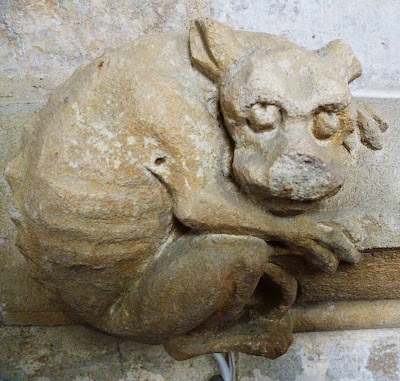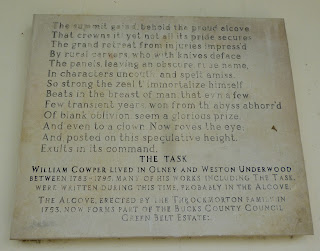The Cowper and Newton Museum website has a tab called 'Plan Your Visit' for visitors to click on, and it was clear and unequivocal that the museum was open on bank holiday Mondays (that is, before they deleted the bank holiday information today: coincidentally(?) just after I had complained to them about the fact that their published hours of opening were incorrect). We had driven to Olney in good faith on 4 June this year (two days ago), which was a bank holiday Monday, and we went with the specific purpose of visiting the museum, but it was closed. Of course, we didn't check with Facebook or Twitter, as the museum House Manager seems to have expected us to: what? After careful reflection, Penny and I consider that someone made an error but won't admit it. Needless to say, we won't be returning: the choice is yours, but the church (see below) is an absolute must.
In 1765 Cowper was a boarder in the Reverend Morley Unwin's home in Huntingdon until Unwin's death in 1767, when he moved to Orchard Side in Olney with the widow Mary Unwin. (He is depicted here with John Newton.)
John Newton (1725–1807) was a former sailor and slaver who had renounced his former ways and been curate of Olney since 1764. Cowper and Newton became friends and wrote Olney Hymns (1779) together.
John Newton's pulpit.
WILLIAM COWPER LIVED IN OLNEY AND WESTON UNDERWOOD
BETWEEN 1783–1795. MANY OF HIS WORKS,
INCLUDING THE TASK, WERE WRITTEN DURING THIS TIME, PROBABLY IN THE ALCOVE. THE ALCOVE, ERECTED BY THE THROCKMORTON FAMILY IN 1753, NOW FORMS PART OF THE BUCKS COUNTY COUNCIL GREEN BELT ESTATE.'
'WILLIAM COWPER
1731 – 1800
POET & LETTER-WRITER
TRANSLATOR OF HOMER
LIVED HERE
1768 – 1786'
In 1765 Cowper was a boarder in the Reverend Morley Unwin's home in Huntingdon until Unwin's death in 1767, when he moved to Orchard Side in Olney with the widow Mary Unwin. (He is depicted here with John Newton.)
John Newton (1725–1807) was a former sailor and slaver who had renounced his former ways and been curate of Olney since 1764. Cowper and Newton became friends and wrote Olney Hymns (1779) together.
The Parish Church of Saints Peter and Paul, Olney.
There is a very interesting stained glass window in the north aisle, which is in thanksgiving for those who returned safely from World War I.
A book shows one of Newton's hymns ('How Sweet the Name of Jesus Sounds') and one of Cowper's ('God Moves in a Mysterious Way').
To the bottom left is a representation of John Newton, with two slaves to the left and a ship to the right. He holds a scroll marked 'OMICRON A. D. 1774': in that year Newton published, under the pseudonym 'Omicron', a book containing 26 letters on religious subjects, along with hymns, etc. Also shown is the (unnamed) De Imitatione Christi (The Imitation of Christ) by Thomas à Kempis, which probably played a strong part in the process leading to his religious conversion.
And to the bottom right is a representation of William Cowper, with Cowper's oak (Cooper wrote a poem called 'Yardley Oak' in 1791) to the left, and Dr Henry John Gauntlett to the right. Some small images are included, such as Cowper's summer house in the garden at Orchard Side; a rough sketch of Orchard Side itself; and a frying pan and tossed pancake (Olney being noted for its Shrove Tuesday pancake race). Cowper's comic poem '(The Diverting History of) John Gilpin' is also mentioned, showing a riding whip and a horseshoe: the poem was originally related to Cowper by Lady Austen to ease his depression, and describes a disastrous journey, with Gilpin on a borrowed runaway horse, on the day of the intended celebration of his 20th wedding anniversary. It was included in the book The Task (1785).
Gauntlett is sometimes called 'The father of church music', and estimates have been made that he wrote the tunes for over ten thousand hymns.
Between Newton and Cooper, inevitably, Cooper's three famous pet hares had to get in on the act.
This lower panel of the south window of the chancel shows Newton preaching in the middle, and the ship caught in the storm played at least a part in his conversion.
'THE ABOVE PLATE IS FROM THE COFFIN OF THE
REVD. JOHN NEWTON,
RECTOR OF ST. MARY WOOLNOTH, LONDON,
AND FOR 16 YEARS CURATE OF THIS CHURCH.'
'To the Memory of
the Rev. MOSES BROWNE,
Chaplain of Morden College,
Blackheath, KENT,
and Rector of Sutton, LINCCINSHIRE [sic],
and who was 34 years Vicar
of this Parish,
who died 13th. September 1787,
Aged 84.
He sleeps in Jesus.'
The vicar Moses Browne employed John Newton as a curate, and also Thomas Scott, who wrote A Commentary on the Whole Bible, which was a bestseller of its day. Scott was the grandfather of the architect George Gilbert Scott.
Before leaving the church, I must add that it's interesting to observe this amusing specimen: an imp, which reminds us that Olney was formerly in the diocese of Lincoln.
'JOHN NEWTON
DIED 21ST. DECR. 1807
AGED 82
––––––––––––
MARY NEWTON
DIED 15TH. DECR. 1790
AGED 61.'
'THESE REMAINS
WERE REMOVED FROM THE CHURCH
OF ST. MARY WOOLNOTH IN THE CITY
OF LONDON AND RE-INTERRED HERE
25TH JANUARY 1893'
'JOHN NEWTON, CLERK,
ONCE AN INFIDEL AND LIBERTINE,
A SERVANT OF SLAVES IN AFRICA WAS
BY THE RICH MERCY OF OUR
LORD AND SAVIOUR JESUS CHRIST
PRESERVED, RESTORED, PARDONED
AND APPOINTED TO PREACH THE FAITH HE
HAD LONG LABOURED TO DESTROY.
NEAR 16 YEARS AS CURATE AT THIS PARISH
AND 28 YEARS AS RECTOR OF ST. MARY WOOLNOTH.'
James Andrews was a monumental mason who lived on the High Street and who gave Cowper drawing lessons.
Cowper and Unwin moved to The Lodge, a house in Western Underwood less than two miles from Olney, in 1786.
The entrance to Cowpers Alcove, Wood Lane, Weston Underwood.
'The summit gain'd, behold the proud alcove
That crowns it! yet not all pride secures
The grand retreat from injuries impress'd
By rural carvers, who with knives deface
The panels, leaving an obscure, rude name,
In characters uncouth, and spelt amiss,
So strong the zeal t'immortalize himself
Beats in the breast of man, that ev'n a few
Few transient years, won from th' abyss abhorr'd
Of blank oblviion, seem a gorious prize,
And even to a clown. Now roves the eye;
And posted on this speculative height,
Exults in its command.
That crowns it! yet not all pride secures
The grand retreat from injuries impress'd
By rural carvers, who with knives deface
The panels, leaving an obscure, rude name,
In characters uncouth, and spelt amiss,
So strong the zeal t'immortalize himself
Beats in the breast of man, that ev'n a few
Few transient years, won from th' abyss abhorr'd
Of blank oblviion, seem a gorious prize,
And even to a clown. Now roves the eye;
And posted on this speculative height,
Exults in its command.
THE TASK
WILLIAM COWPER LIVED IN OLNEY AND WESTON UNDERWOOD
BETWEEN 1783–1795. MANY OF HIS WORKS,
INCLUDING THE TASK, WERE WRITTEN DURING THIS TIME, PROBABLY IN THE ALCOVE. THE ALCOVE, ERECTED BY THE THROCKMORTON FAMILY IN 1753, NOW FORMS PART OF THE BUCKS COUNTY COUNCIL GREEN BELT ESTATE.'
The Alcove ceiling.
The view from the Alcove.
The Alcove from Wood Lane.
The poet is remembered in the name of the village pub, Cowpers Oak.


































No comments:
Post a Comment